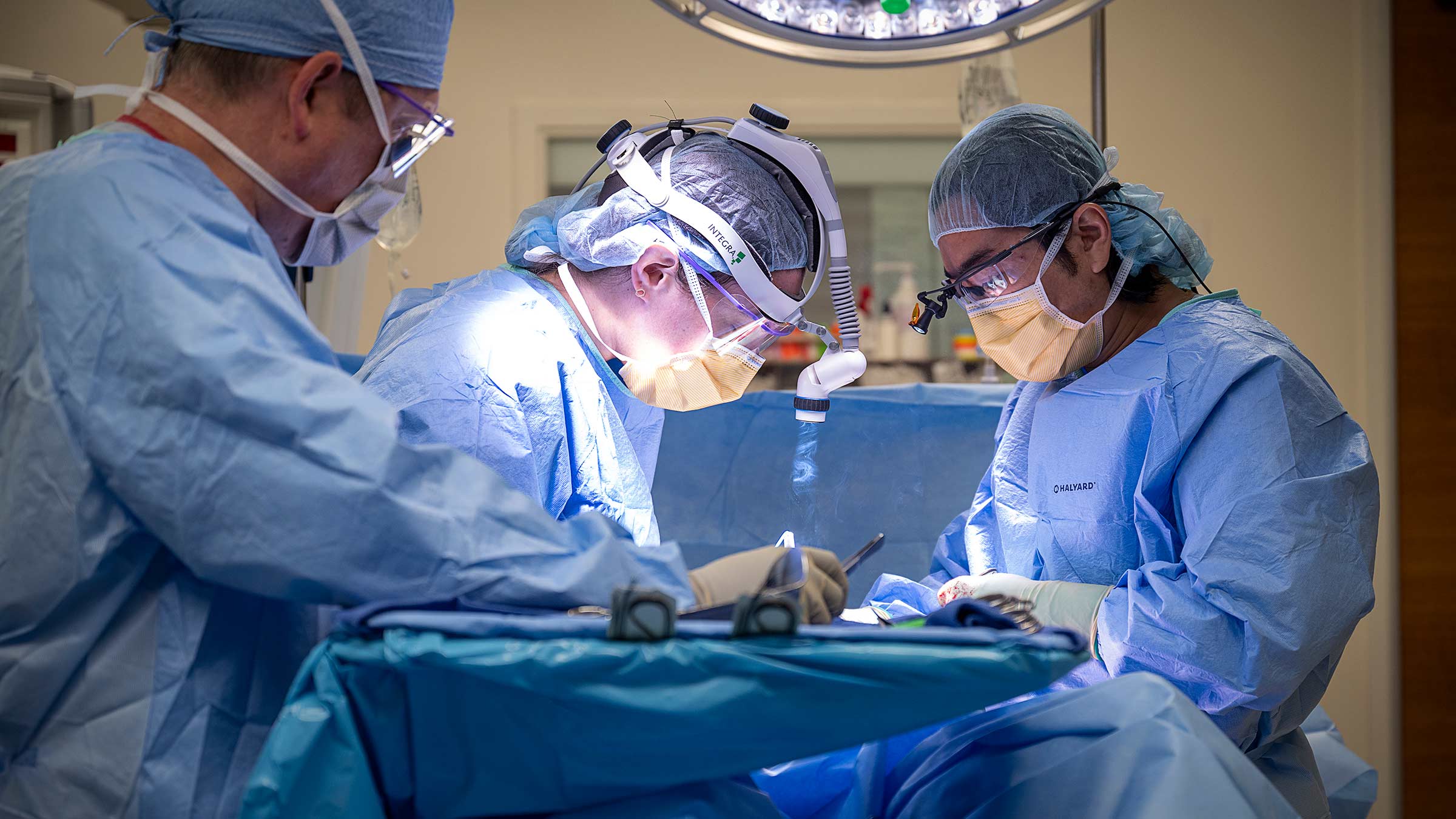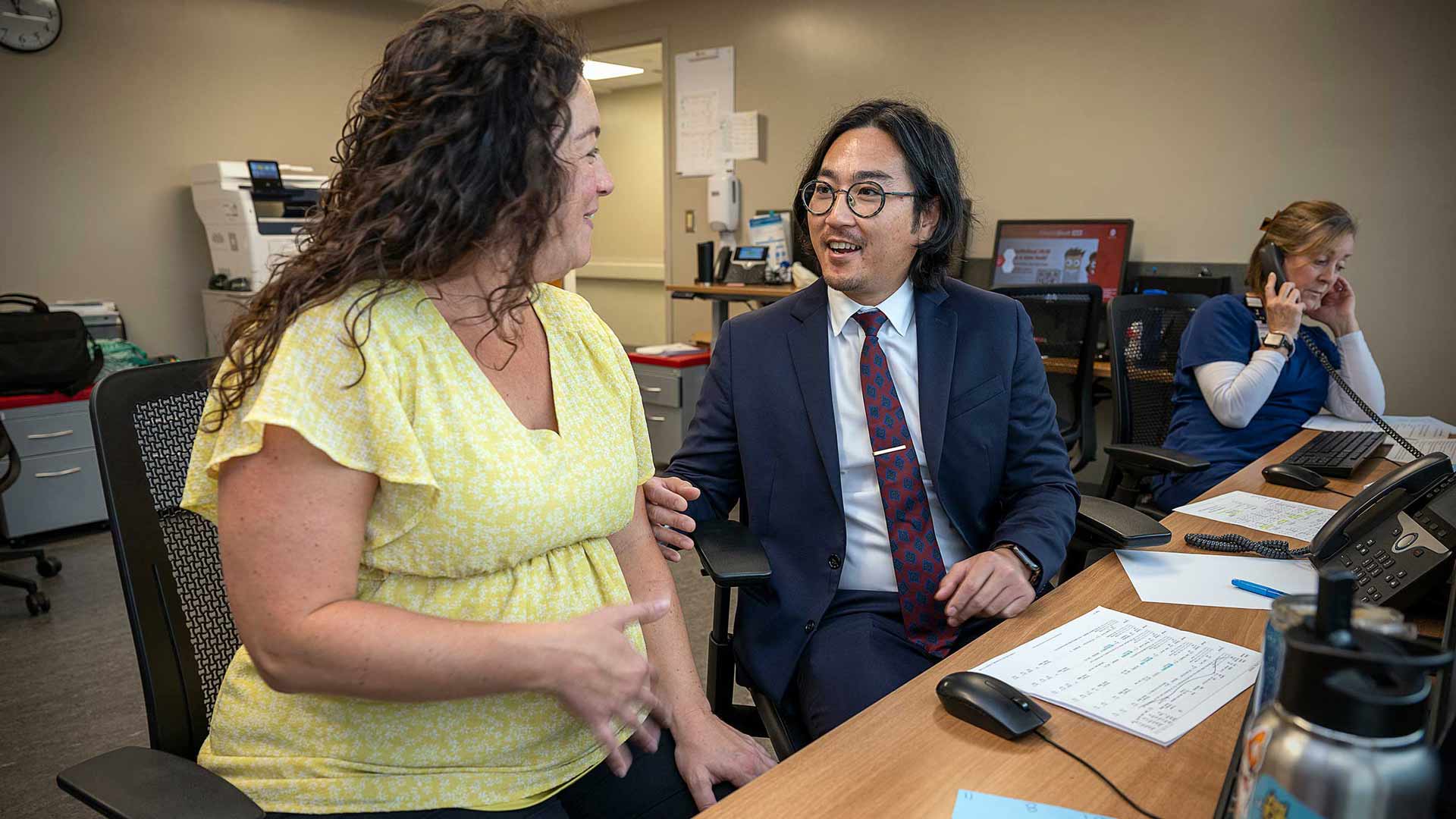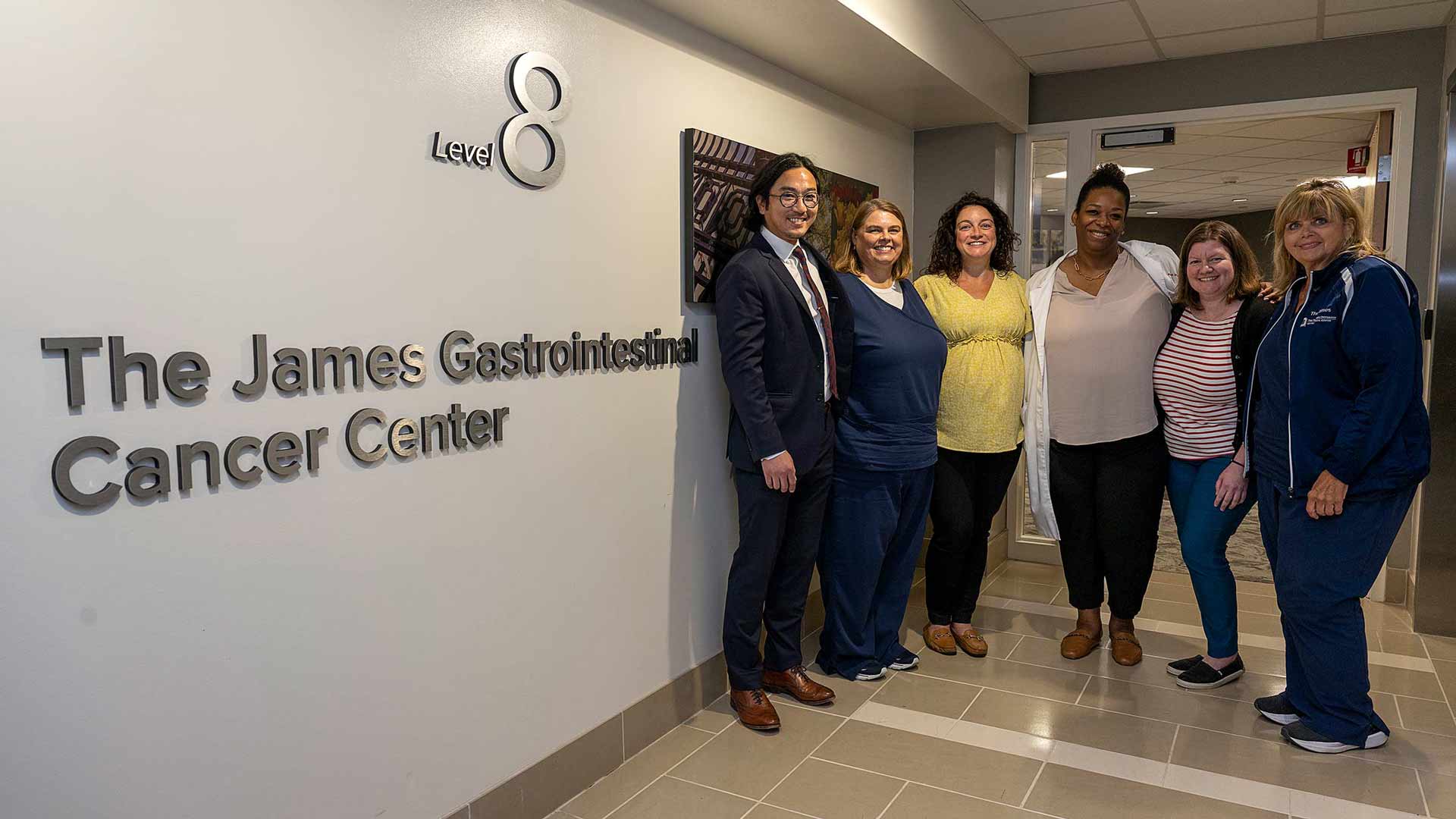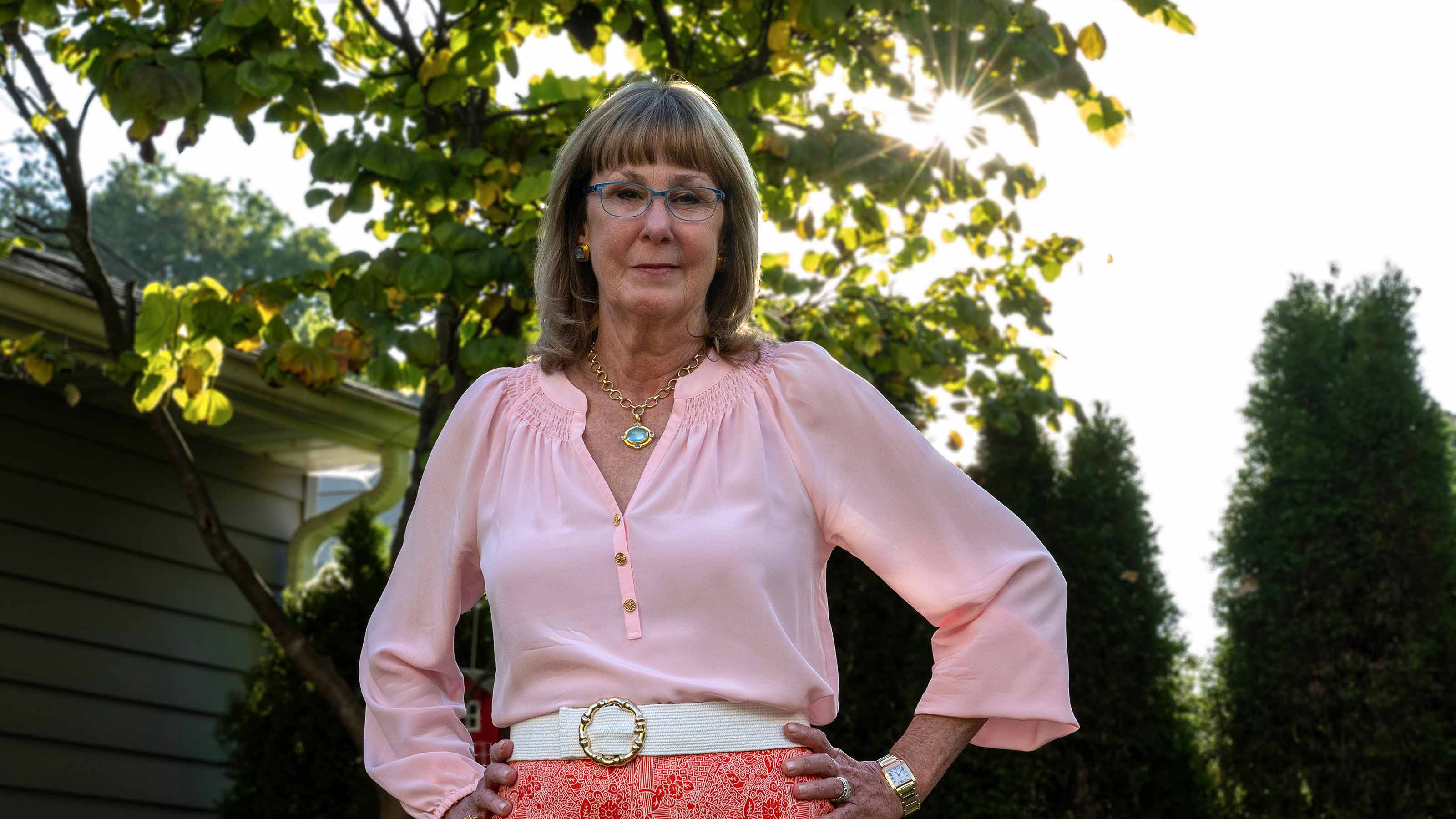Pursuing the ‘holy grail’ of cancer surgery: stopping the spread of cancer to other organs
Alex Kim, MD, PhD, is turning to the operating room and research lab to help treat patients with metastatic cancers spreading in the abdominal cavity.
When given the option, it’s not unusual for long-distance patients to turn down virtual follow-up appointments with cancer surgeon Alex Kim, MD, PhD, preferring instead to make the drive to The Ohio State University Comprehensive Cancer Center – Arthur G. James Cancer Hospital and Richard J. Solove Research Institute (OSUCCC – James).
“They want to come in person to talk to him,” says Joyce Buckley, who schedules Dr. Kim’s patients. “Of course they do, because that’s the kind of person he is. You just want to be around him.”
Buckley understands why many of these patients feel their experiences with Dr. Kim have been the most positive of their cancer journey. Not only does she work with Dr. Kim, but she’s also been his patient.
“The patients see it as soon as they talk to him. They’re given hope, because he shows them, ‘We’re going to tackle this together,’ and has that kind of attitude,” she says. “Imagine a cancer appointment being a positive experience.”
It’s that commitment to patient care that drove Dr. Kim to devote his life’s work to taking on incurable cancers, both in the operating room and in the lab.
“Our holy grail of cancer and oncology is to control metastases — the spread of cancer,” says Dr. Kim, who specializes in treating cancers of the belly cavity at the OSUCCC – James. “That’s why I decided, in terms of my research front and my clinical front, to make this my endeavor, my career and my passion.”
Surgeons, Dr. Kim says, are good at controlling primary cancer — cancer that has not spread. But once it does metastasize, he says, surgeons and oncologists just don’t have good enough treatment options.
“At the end of the day, patients die of metastatic disease,” he says. “We have to do everything in our power to understand how that happens, how we could treat it, and then how we could help patients.”

A new approach to treating cancer that spreads in the abdomen
Dr. Kim has helped expand a program that extends life expectancies for patients with some of the most devastating diagnoses. Using a novel surgical approach combined with targeted chemotherapy, he specializes in treating cancers that start in the appendix, colon, rectum and peritoneum (lining of the belly cavity) and spread throughout the belly cavity.
The two-step operation starts with what’s called cytoreductive surgery — removing all signs of visible cancer — then filling the belly cavity with heated liquid chemotherapy to treat any “invisible” remaining cancer cells.
The chemotherapy process is referred to as HIPEC, short for hyperthermic intraperitoneal chemotherapy. HIPEC directs the chemotherapy to an area of the body that traditional chemotherapy generally doesn’t penetrate. Because the chemotherapy is confined to the belly cavity and not circulated throughout the body, it can be delivered at a higher concentration and higher dosage. The medication, heated to 104 F, kills cancer on contact, with the heat weakening cell membranes.
Paying it forward
Dr. Kim’s scheduler, Joyce Buckley, was 45 in 2021 when she was directed to Dr. Kim for a lesion on her appendix. She remembers him seeing through her façade when she tried to play it cool, giving her a shoulder hug and letting her know, “We’ve got this, and you can let me take it from here.”
Unlike most of Dr. Kim’s patients, Buckley’s growth wasn’t malignant; however, despite not being cancerous, the mucinous tumor had spread throughout her belly cavity. The only treatment option was cytoreductive surgery combined with HIPEC, and her appendix, spleen, gallbladder, ovaries and uterus had to be removed and her intestines opened and inspected.
Before her surgery, she had worked on the same floor of the OSUCCC – James as Dr. Kim. Not long after she recovered, she began working on his team, and she now serves as an on-site example to patients of what life looks like after HIPEC.
“I’m still perfecting how to share it with everybody. But I see how beneficial it is instantly,” she says. “It’s so unknown for anybody. It’s so scary and huge. And then I walk in, and I do a little dance move, and I say ‘Look, I can move. I’m fine. It’s going to be OK.’”
Buckley firmly believes that she went through her ordeal for a reason: so she’d be able to help people who are going through a similar experience. And maybe to help a doctor she considers kind and feels lucky to work with.
“It’s so cool to be able to thank him that way,” she says.
Extending lives with a novel surgical approach
Dr. Kim began his work at the OSUCCC – James in 2020, not only to help grow the surgical HIPEC program, but also to increase access to the procedure.
He’s done a great deal of education and outreach in the community, says Aslam Ejaz, MD, who leads the team of hepatic, biliary and gastrointestinal surgeons at the OSUCCC – James and is an assistant professor in the Division of Surgical Oncology at The Ohio State University College of Medicine. This is particularly important, as many providers may not be aware that patients with metastatic disease may be a candidate for this type of specialized procedure.
That’s helping the OSUCCC – James treat 50-60 patients with HIPEC each year, starting in 2022, compared with 20-25 annually before 2019, and they come from across Ohio and states around the country.
Providing surgery with HIPEC is a massive undertaking. Typically, 12 hours are scheduled for the procedure, and it requires the specialized care of a comprehensive team that includes a surgeon, gastroenterologist, oncologist, pathologist, radiologist, perfusionist and others.
While HIPEC is not a cure, Dr. Kim says it extends lives. For example, 15 years ago, people with colorectal cancer that had spread to the belly cavity were expected to live six to eight months. Now, if such a patient is a candidate for surgery with HIPEC, they could live up to 42 months.
“We’ve come a long way,” Dr. Kim says. “The overall goal is to keep the patient going as long as they can. It’s really hard to say we’re going for a cure, because typically there’s a lot of disease. But if we’re able to remove a majority of it, our goal is to convert severe cancer to a process like a chronic disease, like diabetes or hypertension. Yes, you have to take medications, you have to undergo treatment; however, you could survive longer.”
Patient-centered care
Born in Seoul, South Korea, Dr. Kim is a first-generation immigrant who moved to the United States with his parents in 1989, growing up in a northwest suburb of Chicago.
While studying at the University of Illinois, he first intended to become a chemical engineer, then a chemist, before discovering cancer research and developing a passion for medicine.
“I thought cancer was the epitome of human disease process,” Dr. Kim says. “This was a disease that occurred because people were living longer. So we’re defying evolution, the hardest thing to do in terms of illness.”
It was in medical school at the University of Michigan that he decided to specialize in surgery.
He says he was recruited to the OSUCCC – James to invigorate the HIPEC program clinically and to expand already existing excellent research efforts and clinical trials. He says it was an easy decision to come to the OSUCCC – James to be surrounded by leading oncology experts, and he’s inspired by the institution’s collaborative nature, which drives him to further excel in research endeavors.
Nurse practitioner Katie Berlin, MS, APRN-CNP, says Dr. Kim adapts to offer patients whatever they need in the moment, whether they’re upset or angry, or feeling fear, anxiety or doubt.
“He’ll do whatever he can to make sure the patient is treated and gets the best care that they possibly can,” says Berlin, who sees all Dr. Kim’s patients.
The work involves giving a lot of reassurance and as much hope as possible.
“It’s not only a challenge physically, but emotionally too,” Berlin says. “We’re dealing with people whose life expectancy is a year or two. So, we’re trying to break the barriers of the data on patients with stage IV disease. We do surgeries on these patients, and they may pass away several years later. But both of us want to be there for these patients and help them try to fight.”
Dr. Kim is always searching for inventive, evidence-based treatments, offering patients new therapies that aren’t available in most other centers, Dr. Ejaz adds.

“He takes a very difficult problem and finds a way to come up with innovative solutions for these very tough problems,” he says.
Dr. Kim was responsible for bringing a precision-guided-surgery clinical trial involving cancer in the abdominal cavity to Ohio State. It involves using a novel compound that highlights cancer cells, allowing surgeons to define any disease that gets left behind after the initial organ removal and go back to attempt to completely eliminate disease. The trial revealed that in 50% of cases, residual disease was detected by the compound following cytoreductive surgery — disease that otherwise may have gone undetected if left to the naked eye.
Dr. Kim also heads up a lab of researchers working to identify a mechanism that plays a role in helping cancers spread and survive in the belly cavity, so that hopefully they can one day target them. It’s for these reasons, Dr. Ejaz says, that Dr. Kim was named to lead the regional therapies program.
“Doing the current standard treatment, and then having these research ideas and innovations come through the pipeline — so that as the patients are living longer, we’re able to actually provide them with novel therapies — those are my goals,” Dr. Kim says.

Your support fuels our vision to create a cancer-free world
Your support of cancer care and pioneering research at Ohio State can make a difference in the lives of today’s patients while supporting our work to improve treatment and reduce cases tomorrow.
Ways to Give







